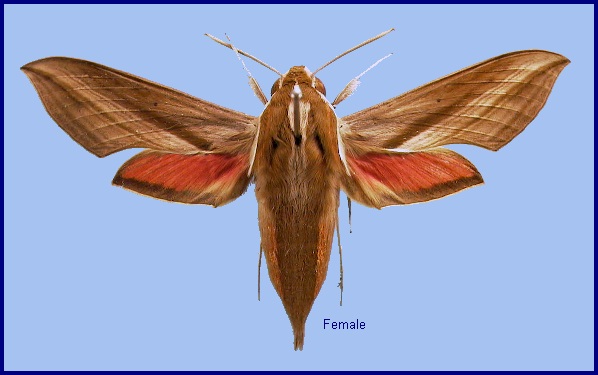

Sphinx boerhaviae Fabricius, 1775, Syst. Ent.: 542. Type locality: not stated.
Synonym. Sphinx boerhaviae Fabricius, 1775.
Synonym. Sphinx vampyrus Fabricius, 1787.
Synonym. Sphinx octopunctata Gmelin, 1790.
[Further details on this species in Japan, as well as photos of many stages, can be found on Digital Moths of Japan.]
Wingspan: 50--68mm. Very similar to Hippotion rafflesii rafflesii but distinguishable by paler upperside to the body and forewings and, in western populations at least, by the buff tornal area of the hindwing upperside. Also very similar to Hippotion rosetta, from which it can be distinguished by the more elongate and contrastingly patterned forewing uppersides, brighter pink hindwing uppersides and, with certainty, by the shape of the juxta. Underside of abdomen generally with a well-defined, narrow, pale, median stripe. Forewing upperside very similar to Hippotion rosetta but pattern brighter and more contrasting, appearing more striped. Hindwing upperside with a buff tornal patch; median area brighter pink than Hippotion rosetta.
Male genitalia similar to Hippotion rafflesii rafflesii but gnathos with clearly longer apical hook. Harpe similar to Hippotion echeclus. Juxta short, distally rounded to obtusely triangular. Phallus with more simple or divided teeth on the left side. In the female genitalia, ostium bursae edges less prominent than in Hippotion rafflesii rafflesii.

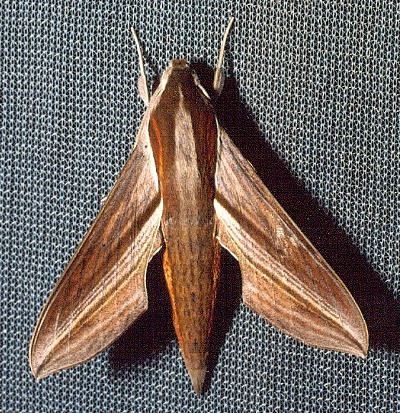
The moth comes to light freely, and sometimes visits flowers before dark (Bell & Scott, 1937). Adults can also travel long distances, either voluntary or involuntary. Bell & Scott (1937) once saw hundreds come on board a ship sailing between Aden (Yemen) and Bombay (India) during a cyclone. On 6.vi.2024 a single specimen was captured at 3100m altitude at Jiaozi Xue Shan/Jiaozi Snow Mountain, Yunnan (ZhenBang Xu, pers. comm. 2024).
China: iv (Hong Kong); 6.vi (Jiaozi Xue Shan/Jiaozi Snow Mountain, Yunnan).
OVUM: Bright green, slightly oval, shiny and smooth (Bell & Scott, 1937).
LARVA: Full-fed 55mm., width 8mm., horn 4mm. According to Bell & Scott (1937), in the final instar head round, clypeus equilaterally triangular, one-half the length of the head. False clypeus forming a fairly broad arch over apex of true clypeus, reaching to two-thirds length of head. Labrum one-half length of clypeus; ligula longer than labrum, its outline square; cutting-edge of mandible coarsely toothed. Surface of head dull and smooth. Body shaped as in others of the genus, with dull and smooth surface. Horn straight rather short and thin, tapering gently to a blunt tip, minutely tuberculate (Bell & Scott, 1937).
In colour, head greyish, with an olive-green tinge. Labrum glassy-white; ligula opaque-white; basal segment of antenna white, other segments reddish; mandible white, tip black. Body greyish tinged with olive-green; segments 6 to 12 with a number of short dark lines across each secondary ring, except on venter. There is a narrow blue dorsal stripe, and a narrow pinkish dorso-lateral stripe on segments 2 to 4 and from segment 11 to base of horn and thence to tip of anal flap. There is also a greyish subspiracular stripe, broad and well defined on 2 to 5, then narrower and ill-defined to 12. A dorso-lateral, rounded eye-spot is present on segment 5, its pupil with the lower half black, shading into rusty in the upper half, in which there is a line of coalescent white dote; the whole edged broadly above, narrowly below with yellow and ridged with black. There are smaller eye-spots on 6 to 11, decreasing in size backwards; pupils yellow shading to rusty above, ringed narrowly with black. All the eye-spots have a small crescent of pale blue above the upper edge. There is also a small round, subdorsal yellow spot mesially on 6 to 11, and a round blue supra-spiracular spot on the same segments. Horn with base pinkish, middle black, tip white; legs pink; venter sparsely dotted with white (Bell & Scott, 1937).
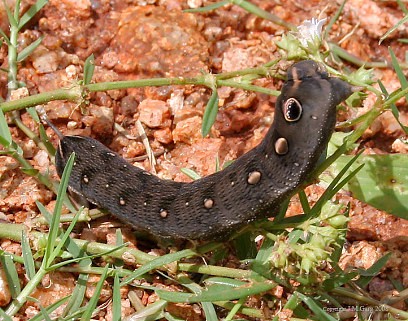
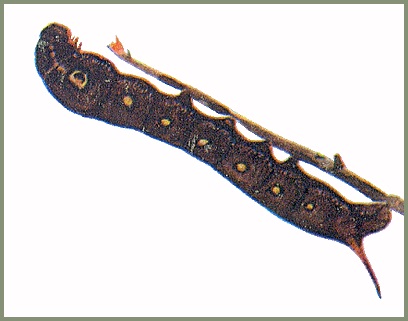
PUPA: 45mm, width 9mm, tongue-case projecting 5.5mm frontad. A lurid bone-colour. Thorax tinted smoky laterally, and head, tongue sheath and thorax speckled with black; inner margin of wing black; abdomen with dorsum pinkish, and an interrupted dark dorsal stripe. The spiracles are black with a pale area round each; pits rusty. Tongue-case projecting nearly as much in front of head as in H. rafflesi, but directed more vented; semi-circular in side-view. Antenna equal to fore leg and reaching to the middle of wing-case, mid-leg to two-thirds length of wing-case. Surface moderately shiny; head and wing-case smooth, thorax and abdomen shallowly transversely corrugate, abdomen also pitted. Spiracle of segment 2 indicated by the front margin of 3 being depressed below the hind margin of 2. Cremaster triangular, broad and deep at base, ending in a needle-like shaft, simply pointed; a small funnel-shaped depression under base (Bell & Scott, 1937).
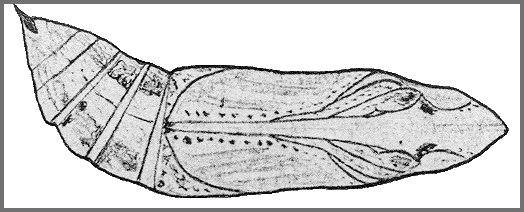
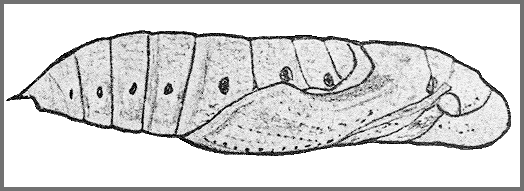
Larval hostplants. Mainly species of Oldenlandia and Spermacoce (Rubiaceae). In India on Impatiens, Spermacoce stricta, S. hispida, Glossostigma spathulatum, Boerhavia repens and B. diffusa (Bell & Scott, 1937).
Unknown.
China: Yunnan (Jiaozi Xue Shan/Jiaozi Snow Mountain, 3100m; Mengbang); Guangdong (Guangzhou); Hong Kong.
Taiwan: [Status unknown].
Japan: Ryukyu Archipelago (Iriomote-jima).
From northeastern Pakistan (Rafi et al., 2014) through India, Sri Lanka, Nepal, Bhutan (Dierl, 1975; Irungbam & Irungbam, 2019), Thailand, southeastern China (Hong Kong and Guangdong), Vietnam (Le & Vu, 2024), the Philippines, the southern Ryukyu Archipelago (Iriomote-jima (Kishida, 1992)), Indonesia, New Guinea, the Torres Straits of New Guinea (Lane & Moulds, 2015) to eastern Australia, the Solomon Islands and New Caledonia.
Records from Japan were originally though to be erroneous due to confusion of this species with Hippotion rosetta (Swinhoe, 1892). To quote Inoue (1989) - "Although Hippotion boerhaviae (Fabricius) has been recorded from the Ryukyu Islands many times, it became apparent by dissection of the genitalia that specimens secured there [and in his collection] belong to Hippotion rosetta (=depictum Dupont & Roepke), not boerhaviae". However, Kishida (1992) confirmed that Hippotion boerhaviae does indeed occur in the Ryukyu Islands by dissecting a male taken on Iriomote-jima in 1986.
Records from Taiwan may also be erroneous and due to misidentifications of Hippotion rosetta; however, in light of Hippotion boerhaviae being reinstated to the faunal list of the Ryukyu Islands, further investigation is required.
Up until recently it was also thought that Hippotion boerhaviae had managed to colonize Hawaii; however, this population is now known to be Hippotion rosetta, not Hippotion boerhaviae.
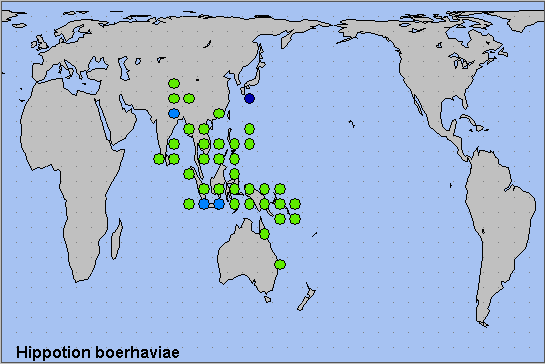
 Return to Sphingidae of the Eastern Palaearctic species list
Return to Sphingidae of the Eastern Palaearctic species list